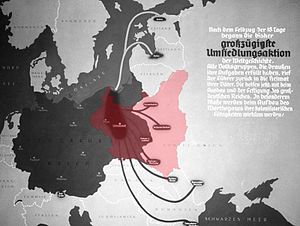
Back هايم إنس رايخ Arabic Heim ins Reich AZ Heim ins Reich Bulgarian Heim ins Reich Czech Heim ins Reich German Heim ins Reich English Heim ins Reich Spanish هایم اینس رایش FA Heim ins Reich French Heim ins Reich Italian
| Berpulang ke Reich | |
 Reich Ketiga pada tahun 1939 setelah penaklukan Polandia | |
| Durasi | 1938–1944 |
|---|---|
| Lokasi | Wilayah yang dikendalikan Jerman Nazi |
| Jeniz | Pembersihan etnis dan pemindahan populasi |
| Sebab | Lebensraum, Generalplan Ost |
| Tokoh | Adolf Hitler |
Heim ins Reich (pelafalan dalam bahasa Jerman: [ˈhaɪm ɪns ˈʁaɪç] ⓘ; berarti "berpulang ke Reich") adalah kebijakan luar negeri yang dilancarkan oleh Adolf Hitler semenjak tahun 1938 pada masa Perang Dunia. Tujuan Hitler adalah untuk meyakinkan semua Volksdeutsche (etnis Jerman) yang tinggal di luar wilayah Jerman Nazi (di Austria, Sudetenland, dan distrik barat Polandia) agar mereka berupaya mengembalikan wilayah tersebut ke "rumah" mereka di Jerman Raya. Kebijakan ini juga mengajak orang-orang tersebut untuk "kembali" dari wilayah di luar Jerman setelah penaklukan Polandia dan ditetapkannya Perjanjian Perbatasan Jerman-Soviet.[1]
Kebijakan ini dijalankan oleh VOMI (Hauptamt Volksdeutsche Mittelstelle atau "Kantor Kesejahteraan Utama untuk Etnis Jerman"). Mereka juga bertugas mengurus semua permasalahan yang terkait dengan Volksdeutsche. Semenjak tahun 1941, VOMI berada di bawah kendali SS.[2]
- ^ Lynn M. Tesser. "Europe´s pivotal peace projects: Ethnic separation and European integration" (PDF). March 2015 Issue 6. European Policy Analysis. Diarsipkan dari versi asli (PDF) tanggal 2017-01-13. Diakses tanggal 2017-07-23.
Heim ins Reich, with approximately 600,000 Germans (Volksdeutsche) moving into designated areas [was approved by Hitler, in] a bevy of population exchange agreements in 1938-40 [including] in a 6 October 1939 Reichstag speech.
- ^ R. M. Douglas (2012). Orderly and Humane: The Expulsion of the Germans after the Second World War. Yale University Press. hlm. 21. ISBN 0300183763. Diarsipkan dari versi asli tanggal 2023-08-17. Diakses tanggal 2017-07-23.
In a keynote address to the Reichstag to mark the end of the 'Polish campaign', Hitler announced on October 6, 1939 ... the Heim ins Reich (Back to the Reich) program. The prospect horrified many ethnic Germans, much of whose enthusiasm for Nazism had been predicated on the expectation that the boundaries of the Reich would, as in the cases of Austria, the Sudetenland, and Danzig, extend to embrace them. The prospect of being uprooted from their homes to face an uncertain future not even in Germany proper, but in the considerably less salubrious environment of western Poland, was much less attractive. So far from rallying enthusiastically to the Führer's call, therefore, many Volksdeutsche greeted the declaration of the Heim in Reich initiative with a deep sense of betrayal.